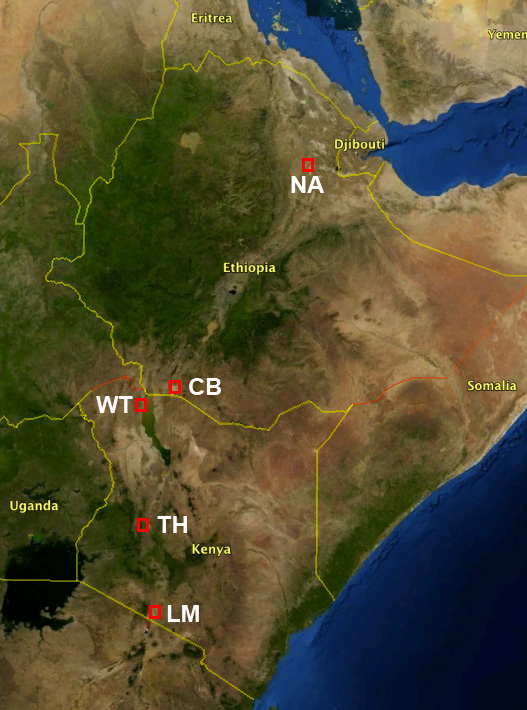
The Hominin Sites and Paleolakes Drilling Project (HSPDP) has collected approximately 2,000 meters of lake sediments from key localities in Kenya and Ethiopia to vastly improve our understanding of the paleoenvironmental/paleoclimatic context of human evolution. Using a combined data collection and modeling approach we aim to fundamentally transform the debate concerning how environmental dynamics at global, regional and local scales may have shaped hominin evolutionary history.
Understanding the relationship between Earth system history and human evolution is an enduring challenge of broad scientific and public interest. Research on this relationship is transdisciplinary across Earth, environmental and anthropological sciences. Key questions include: How did climate and tectonic change interact during critical intervals of human evolution? What processes regulated this history on local and regional scales? Do local records of climate change reflect global changes? How and when did climatic and tectonic processes combine to influence hominin habitats, food resources, and demography? Were these changing conditions related to evolutionary processes and events in the hominin lineage? A recent NRC report (2010) noted how our understanding of the environmental dynamics underpinning human evolution is poised for major advances, because: 1) the places where we can acquire highly resolved paleorecords to evaluate key hypotheses are now well known, and 2) the scientific community interested in this issue has developed a rapidly expanding array of analytical tools available to produce quantitative environmental reconstructions--techniques that previously have not been applied to low-quality outcrop records in hominin-bearing areas. We will obtain continuous paleoenvironmental records by drilling long cores from five high-priority areas in Ethiopia (Northern Awash River and Chew Bahir areas) and Kenya (West Turkana, Tugen Hills and Southern Kenya Rift/Lake Magadi) where highly-resolved, continuous lacustrine paleoclimate records can be collected through important time intervals in the same basins that contain fossils and artifacts. Rather than assume a linkage between environmental history and evolution, we have designed this study as a series of data collection and modeling exercises to explicitly test overarching and local hypotheses about environmental/evolutionary dynamics. Our study will provide a series of well constrained historical experiments, in which congruence of environmental and biotic change can be evaluated.
Our high-resolution (centennial-millennial scale) and datable geochemical, paleoecological and sedimentological records will allow quantitative reconstruction of paleoprecipitation, paleotemperature, paleohydrology and geomorphic evolution at a regional scale. We will correlate these records using high-resolution tephrostratigraphy, magnetostratigraphy and other geochronological techniques to adjacent exposures that contain hominin and other vertebrate fossils, and artifacts, as well as to nearby marine records. Such high-resolution datasets will help identify potential thresholds of environmental change and terrestrial responses in faunal communities. We will develop predictive numerical models of environmental change and ecosystem response during critical intervals of human evolution and evaluate these models against our new, high-resolution paleorecords. These experiments will examine how landscape and climate change across a hierarchy of temporal and spatial scales impacts the durability and predictability of critical ecosystem resources. They will allow us to evaluate the importance of climatic thresholds and abrupt environmental changes and better understand the earth system dynamics that might have shaped the record of human evolution. Our modeling will generate new, testable hypotheses of human evolution/Earth system dynamics, including possible feedbacks from evolving hominin populations to their environments.
This multidisciplinary project includes more than 40 senior scientists from 8 countries. It is currently funded by the U.S. National Science Foundation (NSF), Grants EAR 1123000, EAR 1338553 and BCS 1241859, the International Continental Scientific Drilling Program (ICDP), the Deutsche Forschungsgemeinschaft (DFG), and the National Environmental Research Council (NERC)
 HOMININ SITES AND PALEOLAKES DRILLING PROJECT
HOMININ SITES AND PALEOLAKES DRILLING PROJECT